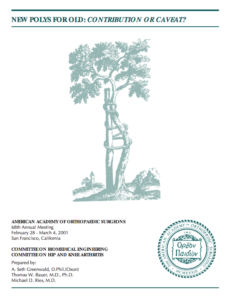 The enduring success of the low friction arthroplasty first advanced by Sir John Charnley as a solution for severe hip arthritic problems may be appreciated from the fact that in 1999 over 500,000 hip and knee arthroplasties were performed in the United States. The percentage of aseptic loosening attributed to polyethylene debris-induced osteolysis is in the single digits for most contemporary series with some reports describing 20 to 30 year patient survivals. Despite this obvious success, polyethylene debris is increasingly identified as the principle causative factor of bone loss and failure of TJA procedures. The conditions of occurrence, severity and clinical consequences suggest limitations on the in vivo integrity of contemporary arthroplasty designs. Material remedies inclusive of carbon reinforced polyethylene (Poly II), heat pressing and Hylamer with its variants have been advanced as alternatives with negative clinical results. Contemporary attempts to improve longevity (i.e., post-processing heat stabilization, peroxide additives and increased radiation with remelting) focus on the benefit of increased cross-linking while minimizing free radical creation. With increasing patient longevity and activity levels a search for the ultimate polymer is important. Variations on an already successful theme hope to lead to its optimization in this century. However, these “new polys” offer no direct clinical evidence to demonstrate their efficacy. It is known that reprocessing techniques will alter mechanical characteristics. Contemporary improvements in laboratory evaluative capabilities suggest significant reduction in component wear, but past experiences, in these regards, have not always predicted their clinical viability.
The enduring success of the low friction arthroplasty first advanced by Sir John Charnley as a solution for severe hip arthritic problems may be appreciated from the fact that in 1999 over 500,000 hip and knee arthroplasties were performed in the United States. The percentage of aseptic loosening attributed to polyethylene debris-induced osteolysis is in the single digits for most contemporary series with some reports describing 20 to 30 year patient survivals. Despite this obvious success, polyethylene debris is increasingly identified as the principle causative factor of bone loss and failure of TJA procedures. The conditions of occurrence, severity and clinical consequences suggest limitations on the in vivo integrity of contemporary arthroplasty designs. Material remedies inclusive of carbon reinforced polyethylene (Poly II), heat pressing and Hylamer with its variants have been advanced as alternatives with negative clinical results. Contemporary attempts to improve longevity (i.e., post-processing heat stabilization, peroxide additives and increased radiation with remelting) focus on the benefit of increased cross-linking while minimizing free radical creation. With increasing patient longevity and activity levels a search for the ultimate polymer is important. Variations on an already successful theme hope to lead to its optimization in this century. However, these “new polys” offer no direct clinical evidence to demonstrate their efficacy. It is known that reprocessing techniques will alter mechanical characteristics. Contemporary improvements in laboratory evaluative capabilities suggest significant reduction in component wear, but past experiences, in these regards, have not always predicted their clinical viability.
New Polys for Old: Contribution or Caveat?
Mar 3, 2001 | General

